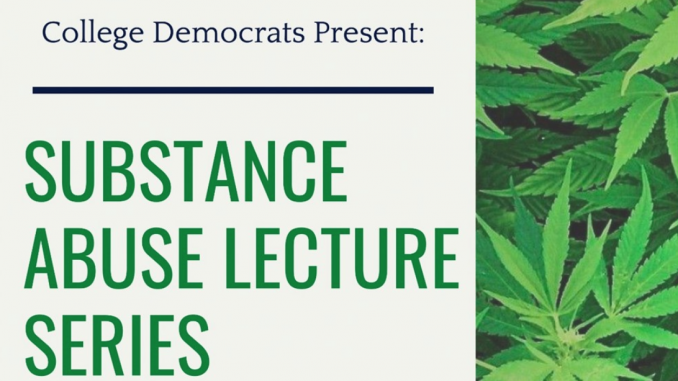
Casey Ryder, Staff Writer |
On Tuesday, Mar. 8, Alcohol and Othe Drugs Counselor Hailey Mancini and Health Educator Rebecca Harrington in collaboration with the College Democrats club held a lecture discussing the history of drug laws in America and their racist impact. In addition, they discussed how public perception has evolved over the years regarding drug addiction and drug use.
Harrington started the lecture off by saying that the Black Lives Matter movement inspired this lecture. She also recalled memories from her childhood of First Lady Nancy Reagan telling the American public to “Just say no” when it came to drug use and she feels that has not been a productive way to prevent the use of drugs.
Mancini then proceeded to discuss the history of a drug that has been the subject of much conversation over recent years in America, Cannabis. According to Mancini, marijuana came over to America with the founding fathers who used it for a variety of purposes including medicinal ones. Mancini also says that marijuana was prevalent in jazz clubs across the country. Of course, jazz clubs were heavily populated with black Americans and since marijuana was also frequently used by Mexican Americans there was a racist caricature created of a cannabis user by those who opposed its recreational use.
She finished by discussing the impact of cannabis on the Vietnam War protest. Mancini says that during the Vietnam War when there were mass protests, one way in which the government was able to break up protests without violating anyone’s first amendment rights was to arrest protesters for possessing cannabis.
The lecture then transitioned to discussing drug laws passed by the Federal Government. Starting with the Anti-Drug Abuse Act of 1986. This law passed during the Reagan Administration, which led to more punitive responses for those convicted of drug offenses as well as established minimum sentences. In addition to that, the bill increased funding for policing which mostly took place in communities of color.
Another bill highlighted by Harrington and Mancini was the Drug Free Schools and Community Act. This bill, which was first passed in 1986 and amended in 1989, requires all K-12 and higher education schools to implement and enforce drug prevention. The law is still in effect today and is quite relevant to Suny Oneonta as part of the bill requires colleges to submit a certification that it has adopted and implemented a drug prevention program in order to receive federal funding.
After shedding light on this legislation and how they affect communities of color, Harrington and Mancini proceeded to talk about other topics related to drugs such as the different ways in which we perceive drug use and addiction. They also discussed medical disease and mental health models for viewing drug addiction.
However, most significantly, they pointed out the strong correlation that exists between high Adverse Childhood Experience (ACE) scores and drug addiction. ACE scores include things such as physical abuse, emotional abuse, domestic violence, etc. Specifically, someone who has an ACE score of 4 has a 700% greater risk of alcoholism than someone with a score of 0.
Lastly, Harrington and Mancini claim that while legalization is a step in the right direction, it doesn’t always solve the problem of racist outcomes of drug laws. For example, when Colorado made recreational cannabis legal for people 21 and over in 2014, arrests of white kids went down 8% while arrests of Hispanic kids went up 29% and arrests of black kids went up 58% in the three years that followed. The reason for this was that it was still illegal for people under the age of 21 to possess cannabis and as a result, there were still discrepancies in terms of arrests of white people and people of color.
Leave a Reply